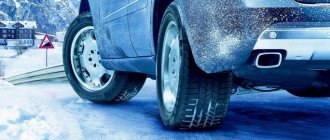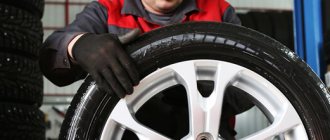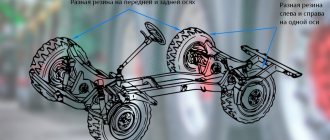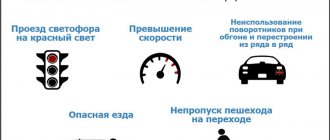To the list of useful itemsAll news
Category: Summer Tire Tests
49181 views49181
Winter has arrived and with the first serious cold, a massive re-shoeing of tires or the purchase of winter tires begins. But such an event cannot be called a whim of car owners. Changing tires is a procedure regulated by law. The nuances of exactly how to carry out such work are described in regulatory documents. The law that regulates all this is called “Technical Regulations of the Customs Union TR CU 018/2011 “On the safety of wheeled vehicles.”
Are there penalties for out-of-season tires?
Back in 2014, bill No. 464241-6 was introduced into the State Duma of the country, which proposed supplementing Article 12.5 of the Code of Administrative Offenses of the Russian Federation with part 3.2:
“Part 3.2 as follows: “3.2 Driving a vehicle in violation of the requirements for the operation of tires and wheels - entails the imposition of an administrative fine in the amount of two thousand rubles.”
For two years, consideration of this bill was postponed, but on October 20, 2021, it was sent for consideration to the State Duma and was to be considered in three readings. But in fact, the bill on a fine for using summer tires in winter did not even pass the first reading , and on November 1, 2021, it was decided to postpone its consideration indefinitely, and as of 2021, consideration of the “tire bill” was no longer started.
Restrictions for driving out of season
Until 2015, the Law did not provide for fines for driving on winter tires in the summer, although there were attempts to introduce it back in 2013. In 2014, the Technical Regulations of the Customs Union were adopted, according to which, from the beginning of 2015, a fine was introduced for driving a car on out-of-season tires .
The regulations include provisions according to which it is prohibited to drive on summer tires in the winter months - December, January, February, and on winter tires in the summer - June, July and August, respectively. That is, driving on any tires in the fall or spring is not considered a violation.
The regulation also states that the rules for the use of seasonal tires can be adjusted according to the weather conditions of each region.
It is clear that somewhere in the northern regions of the country no one drives summer tires due to permafrost, however, amendments to the regulations must be adopted by each region separately, so in the first time after its adoption, misunderstandings may arise with traffic police officers.
So what is the fine for summer tires in winter today?
The issue of changing winter and summer tires in Russia today is NOT regulated by anything, and drivers do not need to fear fines for using summer tires in winter, or sanctions for another version of tires that are not suitable for the season - simply because there are no such fines! Car owners, at their own discretion, decide to replace summer tires with winter ones, based on weather conditions and air temperature. If we talk about specific dates, then in central Russia the unspoken guidelines are November 15 for changing tires from summer to winter, and March 15 for switching from winter tires to summer.
Of course, these dates are rather arbitrary, and they differ in certain regions of the Russian Federation. Drivers, relying on common sense, when changing tires, focus not on dates, but on weather conditions. That is, if it’s already spring on the calendar, and there’s still snow on the roads and the forecast promises icy conditions, then no one will “change their shoes” to summer tires . And if in the warm Crimea or Sochi in November, and sometimes even in December, the weather is sunny, warm, and the road surface is dry and clean, then drivers are unlikely to switch to winter tires urgently.
What penalties were offered for summer tires in winter?
As we said above, rumors that in the near future it will be prohibited at the legislative level to “shoe” a vehicle out of season have been circulating for a long time, and several bills were submitted to the State Duma for consideration, but for various reasons, none passed even the first reading. The essence of these tire bills was as follows:
- To be fined for driving a vehicle using tires that are not in accordance with the season (the driver must use winter tires in the cold months, or “change the car’s shoes” taking into account the average daily temperature.
- To be fined for driving a vehicle on winter tires with studs in the summer.
- Refusal of insurance payment in the event that during an accident the culprit’s vehicle was wearing tires that were not appropriate for the season.
But, as we see, so far all these legislative initiatives have not gone further than bills, and you still decide for yourself when to change tires from summer to winter and vice versa! There is no fine for summer tires in winter in the Russian Federation!
Why can't you drive on winter tires in summer?
Even without studs, winter tires have properties that greatly distinguish them from summer tires. Therefore, there are several important reasons for refusing to use them in the warm season:
- Rubber softens and loses strength.
- The braking distance increases.
- The spikes are destroyed.
- The road surface is damaged.
- The car is more difficult to drive.
- Fuel consumption increases.
Because of this, the likelihood of an accident increases. In addition, there are risks of refusal to reimburse insurance payments due to non-compliance with traffic rules.
Is there a penalty for wearing winter tires in summer?
If you study the Technical Regulations of the Customs Union TR CU 018/2011 “On the safety of wheeled vehicles,” you will find out that it brought new rules for Russian motorists. In this technical regulation, in paragraph 5.5 of Appendix No. 8, there are the following provisions on the use of certain car tires at different times of the year:
- You can drive on summer tires from June to August (they must be studless).
- From December to February, drivers can take part in road traffic while driving a car shod with winter tires (studded or not).
- In the CU regulations 018/2011 you will not find the concept of “all-season tires”.
- Compliance with tire wear limits is mandatory.
At the level of regional authorities, it is allowed to change the months of the established ban on the use of tires by season - these nuances must be recorded in regional regulations.
| Summer tires | Winter studded tires | Winter studless tires | |
| Winter (December - February) | + | + | |
| Spring (March - May) | + | + | + |
| Summer (June - August) | + | + | |
| Autumn (September - November) | + | + | + |
If we talk about whether there is a fine for winter tires in the summer, then this issue has remained unresolved for a long time. At the first stage of discussions, there were proposals to establish a fine of 5,000 rubles for such violations - but such an initiative did not find approval among deputies. There were other proposals regarding the size of the fine for driving in the summer on winter tires.
In fact, in 2021, the fine for driving in the summer on winter tires applies only indirectly under Part 1 of Article 12.5 of the Code of Administrative Offenses of the Russian Federation, that is, if you drove in the summer on winter tires with a heavily worn tread (“bald” tires), the depth of which is less than 4 mm, then
the fine for “bald tires” will be 500 rubles (or a warning).
Summer tires in winter and winter tires in summer – is there a penalty today?
However, among dozens of initiatives that resulted in several draft regulations and draft new laws being developed, not one of them reached official entry into legal force.
Currently, as of May 30, 2021, there is no fine for driving a car with studded winter tires in the summer, as well as with summer tires - there is simply no corresponding article in the Code of Administrative Offenses of the Russian Federation for this violation . Although, the obligation to change shoes still exists.
You will also be interested in:
- Is it possible to drive on winter tires in summer and what is the fine?
- In winter on summer tires: what are the requirements and the penalty?
- When do you need to switch to summer tires from winter tires according to the new law?
But let's look at where the “legs grow” from!
What are the penalties for driving on bald tires in 2021?
The expression “bald tires” has long been used among drivers, meaning driving on tires where the tread has worn out almost completely. According to the new rules, driving on tires with worn tread may result in a fine of 500 rubles (or a warning) . If we turn to the traffic rules and its provisions on the admission of a vehicle to operation, the driver is prohibited from taking part in road traffic if the remaining tread height of the tires of his vehicle:
- freight transport - less than 1 mm;
- passenger car - less than 1.6 mm;
- moped or motorcycle - less than 0.8 mm;
- bus - less than 2 mm.
According to Art. 12.5 of the Code of Administrative Offenses, traffic police officers can issue a fine to the driver for this violation - 500 rubles.
According to rumors, deputies plan in the future at the legislative level to increase the amount of the fine for driving on bald tires by 4 times. Such a jump can be considered quite justified, since a huge number of accidents occur due to the fault of drivers driving on the road on bald tires, especially in the winter months, when the roads are icy.
The dangers of driving on bald tires
Car tires must be replaced periodically, as they are subject to wear due to constant friction. In addition, tires need to be changed twice a year: before the onset of frost, and after winter, when a stable above-zero temperature has established.
Tire treads gradually wear off with use, and at some point the rubber becomes bald. Driving on such tires is dangerous in any weather conditions on any road surface.
We recommend
“Fine for tinting windows: how to avoid or challenge” More
Treads on car tires serve to provide good grip on the road, which is necessary for safe driving at any time of the year.
There are a number of reasons why you should not drive on bald tires:
- If the tread is completely worn out, even on a perfectly smooth asphalt surface, the tires will not provide safe traction.
- In this case, driving a car on a wet road will be impossible, since water flows will literally carry the car.
- Driving on worn tires on ice and mud when the snow is melting is also unsafe. The wheels will simply stop spinning and the car will begin to slide, since bald tires will not be able to remove water from the contact patch, and traction will be lost. In this case, a skid can happen out of the blue. If the tire treads wear unevenly, this can also lead to sudden skidding.
- Operating a car with worn-out tires is also dangerous because the remaining tread can peel off from the tire at any time, and the tire will rupture while driving, which will lead to an accident.
The service life of tire treads depends on many factors, so it is impossible to name a specific time period for the safe operation of rubber. It is important to consider not only seasonality (winter or summer tires), but also the manufacturer.
If you purchase high-quality tires from a trusted manufacturer, their service life will be, on average, 40-50 thousand kilometers. Middle class tires will need to be replaced after about 10-20 thousand kilometers.
Will there be a ban on studded tires?
We talked about the requirements for vehicle tires in different seasons of the year, and now we will consider the question of what changes regarding the use of studded tires are planned at the legislative level.
For countries that are members of the Customs Union, the technical regulation TR CU 018/2011, which we discussed above, establishes the following conditions:
- Studded tires are prohibited from being used in the summer – from June to August;
- Rubber with studded tread must be on all wheels of the vehicle (that is, you cannot have both studded tires and non-studded winter Velcro tires at the same time;
- The maximum number of studs per linear meter of tread is 60 pieces. This requirement will apply to tires that were manufactured after January 1, 2021.
If we talk about potential fines for using tires with spikes today, they are not established at the legislative level! Therefore, drivers from countries that are members of the Customs Union should not yet fear penalties. But the fine for driving a car on studded tires and not having a “Spikes” sign is 500 rubles.
Driving on all-season tires (Velcro) in 2021
It is worth mentioning separately about all-season tires; you can drive a car quite comfortably on them both in winter and summer. Actually, these non-studded all-season tires are designed for road use throughout the year.
Please note that such tires can only be used in winter if they have the markings “M+S”, “M&S” or “MS” (which means “Mud & Snow”, that is, in English “mud and snow” ) and although the use of all-season tires in the winter months is not otherwise permitted, there is still no penalty for this.
How can traffic police officers fine you for tires?
Above, we have already outlined the situation regarding the legislative framework on the issues of seasonal replacement of tires and fines for using tires out of season. A natural question arises: how will traffic police officers directly on the road monitor whether drivers comply with the standards specified above?
Today, there is only one possible way to establish the seasonality of tires - this is to undergo a technical inspection. But even here there were problems. For example, new cars that have just left the showroom may not pass inspection. And with cars in use, not everything is clear either - the responsibilities of their owners include undergoing maintenance only once a year, which means that the tires’ compliance with the season will be checked only once a year.
To summarize, I would like to note that despite the fact that fines for out-of-season tires have NOT been introduced in 2021 , every car owner must take a responsible approach to the issue of the readiness of his vehicle for current road conditions! It is in your best interests to prepare your car as much as possible for certain weather and climatic conditions!
Previous entry Compensation for damage under compulsory motor liability insurance in case of an accident: timing and amount of payments from the insurance company in 2021
Next entry Amounts of state duty for traffic police services 2021 - 30% discount on payment of fees for government services











